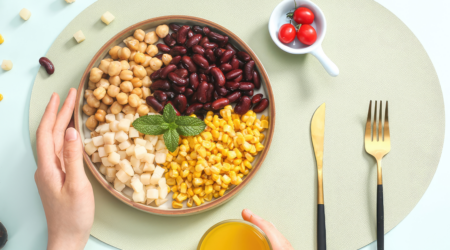What Is The Plate Method? Your Guide to Portion Control and Nutrient Balance
Ever heard of the Plate Method? It’s a simple yet effective way to manage your portions and ensure a balanced mix of nutrients with every meal.
This approach doesn’t require any fancy tools or scales; it’s all about using your plate as a guide to fill your meals with the right proportions of different food groups.
Let’s dive into what the Plate Method is and how you can use it to make healthier eating choices.
Understanding the Plate Method
The Plate Method is a visual tool that divides your plate into sections, each representing a portion of food groups you should include in your meal. Imagine your plate is a pie chart (but much tastier).
This method is especially helpful for those looking to maintain or achieve a healthy weight, manage blood sugar levels, or improve their overall diet quality without the hassle of counting calories or measuring food.
How It Works
Typically, the Plate Method suggests dividing your plate as follows:
- Half of your plate should be filled with non-starchy vegetables. Think leafy greens, carrots, peppers, and tomatoes. These are packed with vitamins, minerals, and fiber, and they’re low in calories.
- One-quarter of your plate should contain lean protein. This includes chicken, fish, beans, or tofu. Protein is essential for building and repairing tissues and keeping you feeling full longer.
- The remaining quarter should be reserved for whole grains or starchy vegetables. Options include brown rice, quinoa, sweet potatoes, or whole wheat pasta. These provide energy, fiber, and other nutrients.
The Benefits
Using the Plate Method can help you:
- Control Portions: Automatically reduces the chance of overeating by limiting high-calorie foods on your plate.
- Increase Nutrient Intake: Encourages a variety of foods, ensuring you get a broad spectrum of vitamins, minerals, and other nutrients.
- Simplify Healthy Eating: No need for tracking every calorie or weighing your food. It’s a straightforward approach to balanced eating.
Tips for Easy Measurement Without Scales
You don’t need a kitchen scale to make the Plate Method work. Here are some handy tips for estimating portions using just your hand:
- Vegetables: Aim for about two fists worth of non-starchy vegetables.
- Proteins: A portion of protein should be about the size of your palm.
- Grains and Starches: A serving of grains or starchy vegetables should be roughly the size of your fist.
Making It Work for You
The beauty of the Plate Method is its flexibility. You can adjust it based on your dietary needs and preferences.
For instance, if you’re following a low-carb diet, you might fill more of your plate with leafy greens and proteins, minimizing the grains and starches. Or, if you’re a vegetarian, you can swap out animal proteins for plant-based alternatives like lentils, beans, or tempeh.
Incorporating the Plate Method into Your Meals
Here’s how to apply the Plate Method to different meals throughout the day:
- Breakfast: Fill half your plate with vegetables (think spinach in an omelet) or fruit, a quarter with protein (like eggs or Greek yogurt), and a quarter with whole grains (such as whole-grain toast or oatmeal).
- Lunch and Dinner: Follow the basic Plate Method guidelines, adjusting the food groups to fit the meal. For example, a salad with grilled chicken and a side of quinoa or a plate with steamed broccoli, baked salmon, and a sweet potato.
For the Whole Family
The Plate Method isn’t just for adults; it’s a fantastic way to introduce kids to various foods and teach them about healthy eating from a young age.
Letting children serve themselves using the Plate Method can empower them to make balanced choices and listen to their hunger cues.
Challenges and Considerations
While the Plate Method is a helpful guideline, listening to your body’s hunger and fullness signals is important. Some days, you might need more or less of certain food groups, and that’s okay.
It’s also crucial to consider the types of foods within each category, opting for whole, minimally processed options whenever possible.
Conclusion
The Plate Method is a practical, no-fuss approach to eating well. It helps take the guesswork out of portion control and nutrient balance, making healthy eating more accessible and less overwhelming.
Whether you’re trying to manage your weight, improve your diet, or teach your family about nutrition, the Plate Method can be a valuable tool in your toolkit.
Ready to learn more about crafting a balanced diet that fits your lifestyle? Check out our guide on a balanced diet for more tips and strategies to eat well and feel great.











